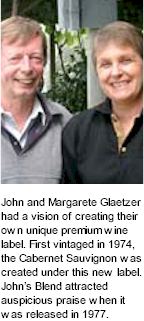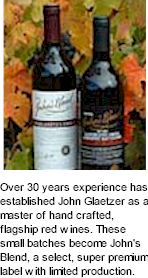About Johns Blend - the Winery
Johns Blend
The constant pursuit of excellence in every aspect of production is the key to the success of John's Blend
John and Margarete saw their vision come to fruition when the 1974 John's Blend was released in 1977. This classic Australian red wine continues the award winning success story of John Glaetzer which has unfolded over many years of wine making for some of Australia's top wine producers. Over 30 years experience has established John Glaetzer as a master of hand crafted, flagship red wines. Small parcels of Cabernet Sauvignon and Shiraz from the alluvial soils of Langhorne Creek and McLaren Vale are crushed, fermented, pressed and blended into oak hogsheads for maturation. These small batches of grapes become John's Blend, a select, super premium label with limited production.

John and Margarete Glaetzer had a vision of creating their own unique premium wine label. First vintaged in 1974, the Cabernet Sauvignon was created under this new label. John’s Blend was an instant success when it was released in 1977. The then youthful John had already worked with some of the greats of Australian wine, including John Vickery and starting work with Wolf Blass after graduating from the Oenology course in 1970. In 1995 a rich and intense Margarete Shiraz was added to the label, a perfect companion to the Cabernet Sauvignon - both wines offer a unique experience to red wine connoiseurs all over the world.
John’s Blend developed side-by-side with numerous Wine Show honours and John’s own prominent role in Wolf Blass Wines as the senior red winemaker. The result was hardly surprising, for John’s part in the story of Wolf Blass Wines, resulted in winning an unrivalled four of the prestigious Jimmy Watson Trophies for Australia’s top red wine 1974, 1975, 1976, and 1999. Also winning eleven Montgomery Trophies for the finest red wines at the Royal Adelaide Wine Show, to name just a few of the awards.
It would be fair to say that in Australia’s fine wine making fraternity there are few others who can share alongside John Glaetzer, the extent and depth of contribution to super premium red wine. John’s Blends are as friendly and rewarding as the winemaker himself, reflecting the rich traditions of Australian finest winegrowing regions and the people who make the wines.

To find out how well John's Blends travel, John Glaetzer decided to put his wine to the ultimate test. He sent one of his daughters on a mission, "..take these bottles to all corners of the world and do not return until they have gone to the extremes." So off his daughter went, the wine was taken (and survived) treks through mosquito infested jungles and packed on top of buses across freezing salt plains.
John's Blend travelled for days down rivers in a dugout canoe, was inspected by a bobby at Windsor Castle and approved by monkeys in the amazon rainforest. They experienced temperature extremes from minus 22 degrees celcius in an igloo in the Swiss Alps to plus 40 degrees while trekking through the Sahara desert on the back of a camel. It lay in the lap of Denmark's famous Little Mermaid and went on a pilgrimage to The Vatican's St Peter's Square. It was exposed to the elements on the rough Atlantic Coast of Ireland and held by a big cigar-smoking, cuban mama in Havana. It reached the extremes of 20 meters below sea level when scuba diving among the corals in the Red Sea off Egypt to an altitude of over 5000 meters in the highlands of the Bolivian Andes.
Most bottles were sacrificed and enjoyed by people of all cultures along the way. The comment by Alpheus, the great creole man from Belize, says it all after he had tasted John's Blend, "Long life to your father!" One bottle made it all the way back to Australia. By this time it had travelled more than 60,000 km across 3 continents and had crossed the equator 6 times. It was a real challenge to taste this bottle which had spent 10 years overseas, against one of the same vintage from Glaetzer's own cellar. Slightly crusted but still fresh and silky smooth, the travelled wine had a soft, silky smooth palate, a delightful red.
